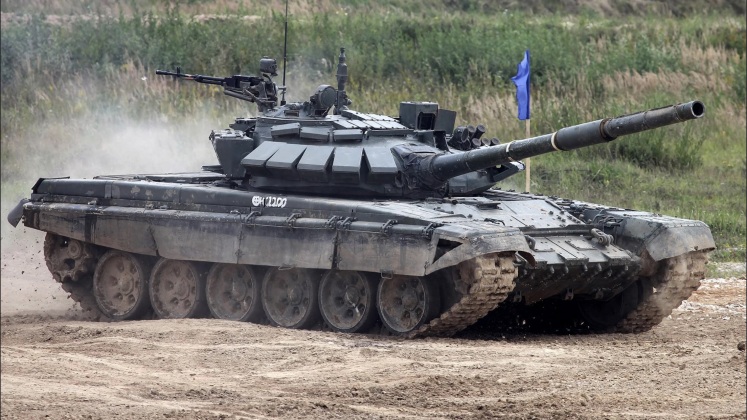News
Why Russia Exported Almost All the Tanks it Built Until 2022: Few New T-90s or T-14s Ordered Until Ukraine War
Entering service from 1992, the T-90 has comprised the vast majority of battle tanks produced in Russia since the end of the Cold War with close to 9000 thought to have been built over 30 years until early 2022. The tank is a derivative of the Cold War era T-72 produced at the Uralvagonzavod factory, and while its performance specifications have varied widely depending on the variant the class has received much larger orders than any overseas post Cold War tank designs. Despite this achievement and impressive performance specifications of later variants, the T-90 before 2022 saw relatively few orders made for the Russian Army itself with only an estimated 420 having been in service domestically at the beginning of 2022. The T-90’s largest operators have instead been outside Russia, namely the armies of India and Algeria, with the former deploying an estimated 1,150 T-90S tanks with hundreds more on order and the latter fielding an estimated 700 T-90SA tanks. India and Algeria have alongside China consistently ranked among Russia’s leading defence clients, and are also leading operators of a range of other systems ranging from Su-30MKI/MKA fighters to S-300PMU2/S-400 air defence systems. Both have ground forces which since the Soviet Union’s disintegration have in many respects been better funded than Russia’s own.

The Russian Army’s reluctance to order larger numbers of T-90s before 2022 had a number of causes, a leading one being the very considerable numbers of T-72 and T-80 tanks inherited after the disintegration of the Soviet Union. While the large majority of these remained in storage, approximately 1400 T-72s had by 2022 been modernised to the T-72B3 and B3M standards. This upgrade package equipped them with a thermal imaging system, the Sonsna-U gunner sight, new automatic transmission, modern radio communications, and the new 2A46M-5 125mm smoothbore gun from the T-90A. The new armaments and fire controls allowed enhanced T-72s to use new munition types such as the 3BM48 armour piercing fin stabilised discarding sabot round and the 9M119M1 anti tank guided missile, and its protection levels were also improved considerably with modern variants of Kontakt-5 or Relikt explosive reactive armour. The modernised T-72 variant was thus considered far superior to the baseline T-90 from 1992, but still less capable than T-90S variants being produced in the 2010s for Indian and Algerian use. Modernisation of existing T-72s was, however, seen as much more cost effective than building new tanks, with the competitiveness of the upgraded tanks being a primary factor preventing major domestic orders for more T-90s.

A second reason for early Russian reluctance to acquire the T-90 was that a much more revolutionary tank was under development in the country under a program dubbed ’T-95,’ which was expected to place the country’s top armoured units far ahead of the rest of the world much as the T-64 had in the 1960s. The T-95 was expected to be considerably heavier at approximately 55 tons, and used a an unmanned remote controlled turret with a 152mm 2A83 smoothbore gun. It would benefit from unprecedented levels of protection and cutting edge fire control systems. While feasible as a Soviet program, post-Soviet Russia was unable to continue its development and cancelled it in late 2010 in favour of a more modest derivative using many of the same technologies – the T-14 Armata. The T-14 was expected to be acquired in considerable numbers from the late 2010s, but like many ambitious Russian tactical weapons programs it suffered from serious delays. The result was that the Russian Army would only further invest in modernisation of Soviet built T-72s and T-80s, and from 2019 began to ordering a small number of modernised T-90 tanks built to to the deeply modernised T-90M standard, the first of which became operational in April 2020.
The future of Russian armour remains highly uncertain, with significant losses among T-72 units in Ukraine thought to have been a primary factor stimulating the Defence Ministry to tremendously increase production of the T-90M for domestic use. The T-14 has also been deployed to Ukraine for testing purposes, although whether the conflict will accelerate work on the program, or divert attentions away from it towards producing more T-90Ms, remains uncertain due largely to the lack of information of the new tank’s status in development. The Defence Ministry was also reported in September to have ordered the Soviet T-80 tank back into production at the Omsktransmash, which other than Uralvagonzavod was the largest factory Russian inherited from the Soviet Union. The T-80’s strong performance in Ukraine, and in particular its mobility, were thought to have been major factors influencing this decision, with the capabilities of new variants expected to comfortably exceed those of the T-90M. The T-80 had served as a higher end albeit much more costly counterpart to the T-72, and derivatives of the tank with unmanned turrets and other next generation features were notably planned in the Soviet Union but not completed due to the state’s disintegration. With a major increase in T-90 orders the class is expected to increasingly form the backbone of the Russian Army’s armoured units, and to remain in production for many years to come with further deliveries to India, Algeria, and potentially to new clients such as Belarus and Egypt.












